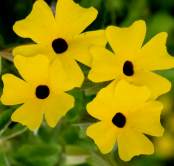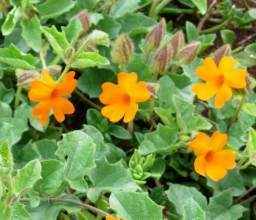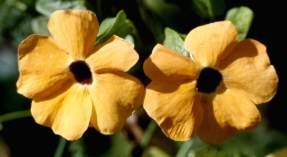Thunbergia alata
Thunbergia alata Bojer ex Sims
Family: Acanthaceae
Common names: black-eyed susan (Eng.); swartoognooi (Afr.) ; isiPhondo (Zulu)
Introduction
In much of the warmer world, Thunbergia alata, or black-eyed susan, is well known as a fast-growing, long-flowering, friendly creeper. In South Africa it is a general favourite as it is not fussy about soil, needs only moderate water, doesn't go rampant, is mostly evergreen and covers ugly places beautifully. It has even been honoured in the standard set of South African postage stamps.

Description
Description
Thunbergia alata is a soft, perennial climber about 1-5 x 1 m with many twining stems. The leaves are heart- or arrow-shaped, softly hairy and sometimes toothed. Many flowers are borne singly in leaf axils with a small calyx enclosed in 2 large, ridged bracts. The corolla is obliquely trumpet-shaped and is usually bright orange in wild plants. The inside of the tube is a striking dark maroon or purplish black. Nurseries also have variants with white, cream- or peach-coloured, yellow to deep orange or nearly red flowers. The fruit is like a bird's head with a spherical base and a long 'beak'. This plant flowers all summer but can continue all year in warmer areas.


©Veronica Orrock
Conservation Status
Status
Thunbergia alata is not a threatened plant at present.
Distribution and habitat
Distribution description
Black-eyed susan is found from tropical Africa southwards through the eastern parts of Limpopo, Mpumalanga and Swaziland to KwaZulu-Natal and Eastern Cape. (It has long been cultivated so the natural areas are not clear.) It has become naturalized in Asia and Malesia and is invasive in Hawaii and Australia. In Africa it is usually found on forest margins but it can occur in dryer, open areas. It is sometimes seen along roads near settlements, but it does not seem to become a nuisance. It needs full sun or light shade. It is half-hardy, needing fairly warm conditions but, with protection, young plants can survive some frost. In cold areas treat it as an annual.
Derivation of name and historical aspects
History
Thunbergia, named in 1780 by Retzius, honours Carl Peter Thunberg (1743-1828), a Swedish botanist, doctor, explorer and author who was perhaps the greatest pupil of Linnaeus. Thunberg spent three years collecting at the Cape of Good Hope, finding about 300 new plant species. He was so keen a collector that, when Japan was closed to all Europeans except the Dutch, he joined the East India Company as a surgeon so he could collect there. Seed of Thunbergia alata, named by Bojer, a German botanist, was sent from Mauritius to England where it was first described by Sims in 1825. (Surprisingly the plant had cream-coloured, not the common orange flowers.) The species name is from the Latin alatus, meaning winged. It refers to the winged petioles but it could also allude to the seeds that have projections looking rather like wings.
Thunbergia alata is one of some 90 old world species of which there are 12 in South Africa. Other species in cultivation are T. natalensis, T. grandiflora Roxb., the blue-flowered Bengal clock vine, from India, and T. gregorii S.Moore, the golden glory vine, with strong orange flowers but no dark 'eye', from tropical Africa and Ethiopia.

Thunbergia gregorii: Image©S.A. Smithies
Ecology
Ecology
Black-eyed susan is probably pollinated by bees. An insect visiting the flower will touch the stigma first, with its back, and then the anthers, getting a load of pollen that is then carried to another stigma. The flowers reflect ultra violet light in a pattern that is visible to insects but not to humans. This helps insects find the centre of the flower. Seeds are perhaps ejected mechanically when the fruit splits open. A butterfly, Junonia ovithya, or the eyed pansy, and moths also visit these plants to lay eggs, for the larvae eat the leaves. Hence this creeper, being attractive to insects, helps bring birds into a garden. Birds also often nest in the thickly tangled stems.

Uses
Use
Used mainly as an ornamental plant, Thunbergia alata makes a good screen when used to cover unsightly dead trees or walls. It needs some support, as it cannot cling. Use fences, trellises, arches, arbours and pillars or a lightly shading tree. (Pergolas would probably be too big.) Alternatively, plant this creeper in groups as a ground cover, or on a bank or terraces where it can trail downwards. Hanging baskets are also a possibility.
In East Africa, black-eyed susan is used as a vegetable or stock feed. Medicinally it is used for skin problems, cellulitis, back and joint pains, eye inflammation, piles and rectal cancer. Gall sickness and some ear problems in cattle are also treated with this plant. Some people can get contact dermatitis from it.
Growing Thunbergia alata
Grow
Seed germinates easily in a damp mixture of fine humus-rich soil with some sand. A glass sheet on top helps keep the soil moist but do allow some air to circulate. Newspaper on top of the glass will help germination by keeping the seeds dark. Mature plants may have seedlings underneath ready for transplanting. Use light soil rich in humus but with good drainage and add some super phosphate. Water the plant well at first and then moderately all year but especially in summer. Add compost at planting time and again 2 or 3 times per summer, as a mulch. Give an occasional dressing of fertilizer for flowering plants (with ratio of N:P:K = 3:1:5) or a general fertilizer (ratio of 2:3:2).
Black-eyed susan grows quickly and starts flowering at an early age. It can be trimmed if it gets too big but it is usually well behaved. Light trimming in spring will encourage flowering. If frost is a problem, cut the plant right back and it will probably resprout.
Caterpillars may be a problem but the plant usually has enough leaves to satisfy them. (The butterflies and moths are a bonus anyway!) Less vigorous plants, perhaps growing in shade, may battle with other insects but birds should help control them. If necessary try to remove the insects by hand or use a soap solution.
Blue and orange look well together so try planting black-eyed susan near Felicia amelloides, Merwilla plumbea and blue Agapanthus. This creeper would go well behind white Agapanthus, Dietes grandiflora and Carissa macrocarpa (Natal plum or amatungulu). White-flowered shrubs or small trees, such as Gardenia thunbergia, Duvernoia adhatodoides (pistol bush) and white Plumbago auriculata would also look good, although the last might have to be checked from taking over. The bright leaves and flowers of the creeper would contrast well with conifers or Podocarpus. Another attractive partner is the twining Senecio macroglossus (flowering ivy). Grouping T. alata with other species would be interesting, including T. atriplicifolia ( Natal primrose), T. dregeana ( haarbossie), T. natalensis ( Natal bluebell) and T. neglecta.
References
- Arnold, T.H., Prentice. C.A., Hawker, L.C., Snyman, E.E., Tomalin, M., Crouch, N.R., & Pottas-Bircher, C. 2002. Medicinal and magical plants of southern Africa: an annotated checklist. Strelitizia 13: 8. National Botanical Institute, Pretoria.
- Botha, C. & Botha, J. 2006. Bring butterflies back to your garden: 161. KwaZulu-Natal Coastal Branch of the Botanical Society of South Africa, Mayville.
- Burring, J. & Van der Walt, L. 2006. The weed exchange. Veld & Flora 92: 18-22.
- Joffe, P. 2001. Creative gardening with indigenous plants. A South African guide: 361. Briza Publications, Pretoria.
- Johnson, D., Johnson, S. & Nichols, G. 2002. Down to earth-gardening with indigenous shrubs. Struik, Cape Town.
- Lawrence, G.H.M. 1951. Taxonomy of vascular plants: 25. Macmillan, New York.
- Mabberley, D.J. 1997. The plant-book, edn 2: 712. Cambridge University Press.
- Phillips, E.P. 1924. Thunbergia alata. The Flowering Plants of South Africa 4: t. 148.
- Pooley, E. 1998. A field guide to wild flowers of KwaZulu-Natal and the eastern region. Natal Flora Publications Trust, Durban.
- Retief, E. & Reyneke, W.F. 1984. The genus Thunbergia in southern Africa. Bothalia 15: 107-116.
- Sims, J. 1825. Thunbergia alata. Winged-leaved Thunbergia. Curtis's Botanical Magazine 52: t. 2591.
- Walker, J. 1996. Wild flowers of KwaZulu-Natal : 150, 151. W.R. Walker Family Trust, Pinetown.
Credits
Shirley Smithies
National Herbarium, Pretoria
January 2007
Plant Attributes:
Plant Type: Climber, Perennial
SA Distribution: KwaZulu-Natal, Mpumalanga
Soil type: Sandy, Clay, Loam
Flowering season: Early Summer, Late Summer
PH: Acid, Alkaline, Neutral
Flower colour: Red, White, Cream, Yellow, Orange
Aspect: Full Sun, Morning Sun (Semi Shade), Afternoon Sun (Semi Shade)
Gardening skill: Easy
Special Features:
Horticultural zones











Rate this article
Article well written and informative
Rate this plant
Is this an interesting plant?
Login to add your Comment
Back to topNot registered yet? Click here to register.